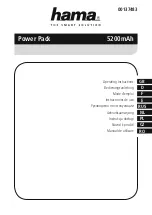
29
Interface Management Commands
LOCAL
Go to local. This does not release any active interface lock so that the lock
remains with the selected interface when the next remote command is
received.
IFLOCK
Request Instrument ‘lock’. This command requests exclusive access control of
the instrument. The response is ‘1’ is successful or ‘-1’ if the lock is un-
available either because it is already in use or the user has disabled this
interface from taking control using the web interface
IFLOCK?
Query the status of the interface ‘lock’. The return value is ‘1’ if the lock is
owned by the requesting interface instance; ‘0’ if there is no active lock or ‘-1’ if
the lock is unavailable either because it is in use by another interface or the
user has disabled the interface from taking control via the web interface.
IFUNLOCK
Release the ‘lock’ if possible. Returns ‘0’ if successful. If this command is
unsuccessful ‘-1’ is returned, 200 is placed in the Execution Error Register and
bit 4 of the Event Status Register is set indicating that you do not have the
authority to release the lock.
ADDRESS?
Returns the bus address <
NR
1><
RMT
>. This number can be used to identify
the unit
IPADDR?
Returns the present IP address of the LAN interface, provided it is connected.
If it is not connected, the response will be the static IP if configured to always
use that static IP, otherwise it will be 0.0.0.0 if waiting for DHCP or Auto-IP.
The response is nnn.nnn.nnn.nnn<
RMT
>, where each nnn is 0 to 255.
NETMASK?
Returns the present netmask of the LAN interface, provided it is connected. The
response is nnn.nnn.nnn.nnn<
RMT
>, where each nnn is 0 to 255.
NETCONFIG?
Returns the first means by which an IP address will be sought.
The response is <
CRD
><
RMT
> where <
CRD
> is DHCP, AUTO or STATIC.
The following commands specify the parameters to be used by the LAN interface.
Note:
a power cycle is
required after these commands are sent before the new settings are used (or returned in response to the
queries listed above). The instrument does not attempt to check the validity of the IP address or netmask
in any way other than checking that each part fits in 8 bits. The rear panel LAN RESET switch will override
these commands and restore the defaults as described earlier.
NETCONFIG <
CPD
> Specifies the means by which an IP address will be sought.
<
CPD
> must be one of DHCP, AUTO or STATIC.
IPADDR <quad>
Sets the potential static IP address of the LAN interface (as on the
webpage).
The parameter must be strictly a dotted quad for the IP address, with
each address part an <
NR
1> in the range 0 to 255, (e.g.
192.168.1.101).
NETMASK <quad>
Sets the netmask to accompany the static IP address of the LAN interface.
The parameter must be strictly a dotted quad for the netmask, with
each part an <
NR
1> in the range 0 to 255, (e.g. 255.255.255.0).



































